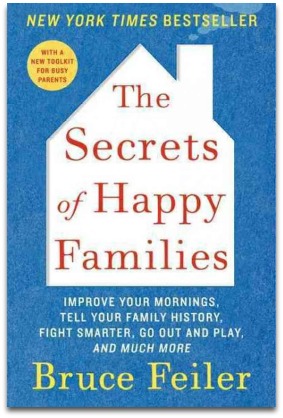 Wonk. Bummy-wup. Giffis.
Wonk. Bummy-wup. Giffis.
Do you understand any of these words? If so, then congratulations, you are a member of my family.
(If you’re not, FYI: the words mean milk, tuck in for bedtime, and breakfast, respectively.)
It was only when I got married that I realized how unique my family vocabulary is.
Almost daily, I would say something that would be met with a blank stare by my husband. So much so that I had to compile a “family dictionary” translating the distinct words, phrases, and inside jokes frequently referenced by my family.
All families have stories to tell—whether it’s about the origin of an odd word like “giffis,” or about how Grandpa survived a battle in WWII or Grandma battled cancer or Uncle Joe battled raccoons at a family campout.
If you identify, refine, and share stories about your family—triumphs and challenges, quirks and strengths—you can make your family happier and more resilient and close-knit.
Why Family Stories Matter
Your kids may yawn or even roll their eyes at dinnertime when you trot out the story of, say, how you met their mother.
Or they may not get enough of those tall tales and beg you to repeat them every chance they get.
Whatever their response, a growing body of research shows that teaching children about their family history yields just about every benefit a parent could wish for their kids:
- Greater family functioning and cohesiveness (source)
- Better understanding of other people’s thoughts and emotions (source)
- Higher self-esteem and stronger self-concepts (source)
- Better coping skills and lower rates of depression and anxiety (source)
- Stronger internal locus of control (source)
 Bruce Feiler, New York Times family columnist and most recently the author of The Secrets of Happy Families
Bruce Feiler, New York Times family columnist and most recently the author of The Secrets of Happy Families, writes:
the single most important thing you can do for your family may be the simplest of all: develop a strong family narrative.
Based on the research, he says, how well children know their family history is “the best single predictor of children’s emotional health and happiness.”
Awareness of family history fosters in children a strong “intergenerational self,” meaning they learn to make sense of their life based on their family’s experiences as well as their own past experiences and feel that they belong to something bigger than themselves.
How to Forge Those Family Stories into Strong Bonds?
Here’s how to make the most of your family stories—it really is simple.
Step 1: Identify your family story
What is your family’s story? Do your kids know what it is?
Researchers at Emory University developed a quiz of 20 yes/no questions to ask children if they knew things like how their parents met or where their grandparents grew up. You can find the “Do You Know” family history questions here to test your child’s (and your own) knowledge.
Of course, a family’s story is much more than dates and places. As Feiler noted, what you need is a strong family narrative.
According to Marshall Duke, an Emory University psychologist, the healthiest framework for your family narrative is called the oscillating family narrative. It’s neither a rags-to-riches nor a riches-to-rags story—it’s about highlighting both the ups and downs your family has faced, and how they’ve gotten through it and managed to stick together.
Of course, not every family story you tell has to be an inspiring tale of grit and triumph. It’s also important simply to celebrate what makes your family unique.
In their (old-school but still totally useful) book Teaching Your Children Joy, Linda and Richard Eyre advise to view your family as a great institution, as “something with rules and traditions and pride.”
That means you can (and should) celebrate your family’s quirky traditions just as much as any noble accomplishments from your past.
Step 2: Refine your family story
 If you miss any questions on the “Do You Know” test, find out the answers! Think about the types of stories you are curious to learn more about, particularly stories that will help build that strong family narrative of making it through ups and downs.
If you miss any questions on the “Do You Know” test, find out the answers! Think about the types of stories you are curious to learn more about, particularly stories that will help build that strong family narrative of making it through ups and downs.
- Look through scrapbooks, journals, or other family memorabilia you have access to.
- Try sleuthing through census records and other family history resources on Ancestry or FamilySearch.
- Ask extended family members what they know.
- Set up a series of interviewers with an older relative and record them sharing their memories. If they live far away, you can get a Google Voice phone number, which allows you to easily record phone calls and get the audio file in your inbox (the catch is that they have to call you; then just press 4 to record). Then transcribe it and turn it into a personal history of the relative. If you don’t have time or aren’t sure where to start, services like StoryWorth can help.
- Organize a family reunion (as large or small as you want it) to swap stories and family history sources.
Step 3: Retell and reinforce your family story
 Your inner Type-A parent may feel inclined to sit your kids down for a lecture strewn with character-building lessons from your past. But the key is to find natural opportunities to bring up family stories.
Your inner Type-A parent may feel inclined to sit your kids down for a lecture strewn with character-building lessons from your past. But the key is to find natural opportunities to bring up family stories.
Prime-time for story-sharing includes dinnertime, bedtime, family vacations, holidays, birthdays, and other milestones.
Stories can take many forms, too. Here are a variety of ways to incorporate family stories in your life:
- Make a traditional scrapbook or print a custom photobook using a service like Blurb, Shutterfly, or Pinhole Press.
- Write a personal blog — your kids will enjoy it someday.
- Get family dinnertime conversation started with Table Topics cards
.
- Listen to audio of personal history interviews with a family member.
- Watch family home videos — if you have old-school VHS videos, convert them to DVDs using a service like Legacybox so you can enjoy them just as easily as your latest smartphone videos.
- Get a free group messaging app like GroupMe, Whatsapp or Signal to easily share the latest family pictures and videos.
- Continue doing traditions and activities your family enjoys and values — get some great family bonding ideas here.
- Check out the book Tell Me a Story: Sharing Stories to Enrich Your Child’s World
by Elaine Reese for more ideas on family storytelling.
The 2-Minute Action Plan for Fine Parents
For our quick contemplation questions today, consider these:
- What stories from your personal and family history demonstrate how you or your family members have overcome challenges?
- What values are important to your family?
- What traditions do you hold dear?
- What about your family makes you proud?
- Have you shared these with your kids?
The Ongoing Action Plan for Fine Parents
Pick one idea from Step 2 and one from Step 3 to work on.
Perhaps give a parent or grandparent a call to glean a story from the past. Tonight at dinnertime or bedtime, try to work in a story from your own life that your kids haven’t heard before. And consider writing down all (or at least some) of the funny things your kids say and the odd words and phrases your family uses — you can compile your very own family dictionary.
Loved this article, thanks so much for sharing, it brought back memories and reminders of similar experiences in our family.
Like many families, we have some words that nobody else would understand. It’s a way we form special bonds. It’s being on the “in crowd”. I also had to learn to appreciate that other people don’t use those words, so there is a place and time too. All part of building social awareness.
I love this article, and I so agree that a family’s story is so very important to pass down to the children. Every family has a story, and every family member needs to know what that story is. Thank you so much and I’ll be sharing this article.
Thanks, Kristine!
I hope i can pass on my values to my son.
You nailed it, Clint. That’s something we all hope for!